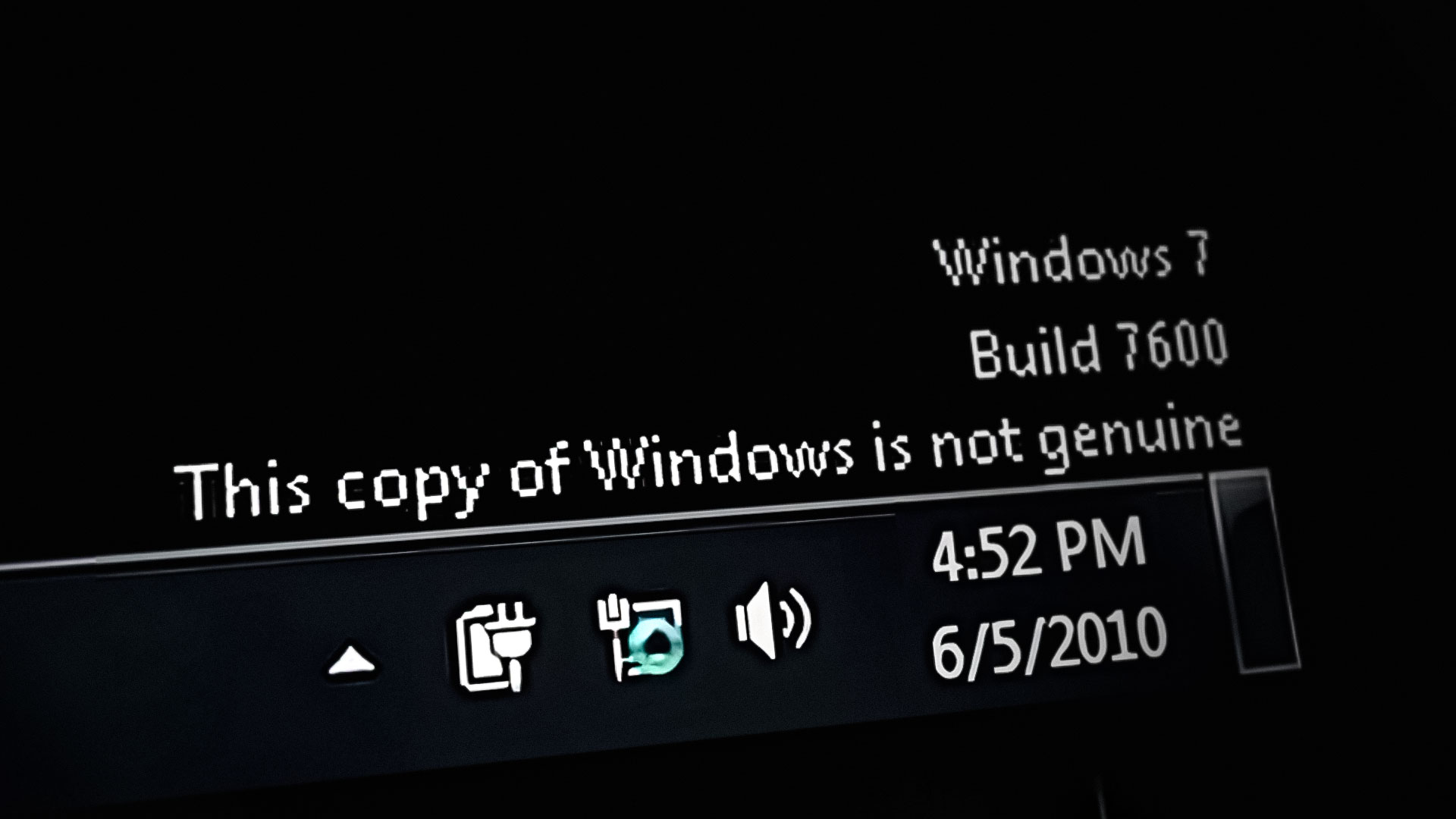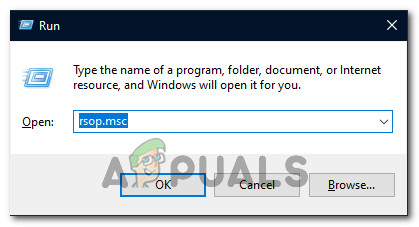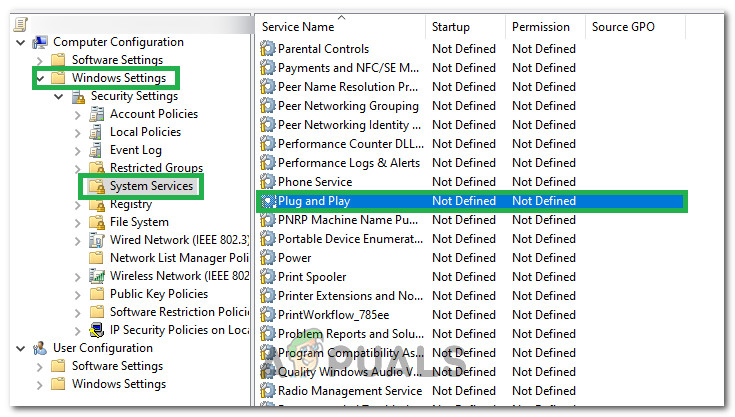SOLVED: Removing “This Copy of Windows Is Not Genuine”
Windows displays the ‘This copy of Windows is not genuine’ message if your Windows is not activated properly. Activation of Windows is necessary so that Microsoft can ensure you have obtained Windows legally.
This error message usually indicates that Windows was not obtained through official means, and it turns your wallpaper black along with an annoying message that appears in the lower-left corner of the screen. The error message varies depending on the build version of your Windows. For example, if Windows 7 Build 7600 is not activated properly, the error message will look like this:
Windows 7 Build 7600 This copy of Windows is not genuine

History of this Error
This is quite similar to the message, “You may have been a victim of software counterfeiting,” that would appear on computers running Windows XP if their copies of the OS were detected as pirated. Although this technology is designed to display the “This copy of Windows is not genuine” message only to users with pirated copies of Windows 7, it sometimes slips up and displays the message to Windows 7 users who own completely legitimate copies.
This is especially the case for Windows 7 users who own completely legitimate OEM versions of Windows 7 – the versions that came pre-installed on their PCs or laptops from their manufacturers, and it displays an activation error.
How can I fix this ‘Windows is not Genuine’ error?
Fortunately for you, though, the “This copy of Windows is not genuine” message can certainly be removed along with the black background that came with it. If you’re affected by this problem, regardless of whether you’re using a legitimate version of Windows 7 and are interested in knowing how to resolve this issue, here’s how you can do so:
Step 1: Uninstall update KB971033 (if applicable).
First and foremost, you must uninstall update KB971033 from your computer. However, keep in mind that this is only part of the solution for removing the “This copy of Windows is not genuine” message and will not be able to fix the issue by itself. To uninstall update KB971033, you need to:
- Open the Start Menu.
- Search for “windows update”.
- Click on the search result titled “Windows Update” under the Programs
- Click on View installed updates in the left pane.
- Once all of your installed updates have been loaded and you can see them in the right pane, search for update KB971033. When you find it, right-click on it and click on ‘Uninstall‘ in the contextual menu
- Go through the uninstallation process and then restart your computer. Move on to Phase 2 once your computer boots up.
Step 2: Reset the licensing status of your computer.
Once you have uninstalled update KB971033, you need to reset the licensing status of your computer to ensure you no longer encounter the “This copy of Windows is not genuine” message on your desktop. To accomplish this, you must:
- Open the Start Menu.
- S:Search for “cmd.
- Right-click on the search result named “cmd” and click on “Run as administrator.” This will launch an elevated Command Prompt with administrative privileges.

Running Command Prompt as an administrator - Type the following command line into the elevated Command Prompt and press Enter:
slmgr -rearm
- You will see a confirmation window. Click on OK.
- Restart your computer; once it boots up, you will notice that the “This copy of Windows is not genuine” message is no longer present. Your desktop will still display a blank, black background, but you can resolve this by right-clicking on an empty space on your desktop, selecting “Personalize,” and changing your desktop background.
Note: The SLMGR -REARM command line is designed to work on 32-bit versions of the Windows 7 OS, and it works on almost all 32-bit versions of Windows 7 and a few 64-bit versions of Windows 7. However, if you use this command line and see that the “This copy of Windows is not genuine” message still appears when you restart your computer, you may have better luck repeating the steps listed and described above, but this time, use the following command line instead of SLMGR -REARM.
slmgr /rearm
If you run the “slmgr -rearm” or “slmgr /rearm” command-line and receive an error message stating, “This maximum allowed number of rearms has been exceeded,” you need to go through the following steps in order to fix the issue and proceed with Phase 2:
- Press the Windows Logo key + R to open a Run dialogue box.
- Type regedit.exe into the Run dialog and press Enter.

Open Regedit - In the left pane, navigate to the following directory:
HKEY_LOCAL_MACHINE > Software > Microsoft > WindowsNT > Current version
- In the left pane, click on the SoftwareProtectionPlatform folder to display its contents in the right pane.
- In the right pane, locate and right-click on a registry value named SkipRearm, then click on Modify in the context menu.
- In the Modify dialog box, change the Value data for the key from 0 to 1, and click on OK.
- Exit the Registry Editor and restart your computer. When your computer boots up, give Phase 2 another try, and you should be successful this time.
If you run the SLMGR –REARM or SLMGR /REARM command-line and receive an error message stating that “SLGMR is not recognized as an internal or external command,” the cause can be one of three things – you are typing the command-line incorrectly, you are not typing the command-line into an elevated Command Prompt that you are running as an administrator, or there is a problem with your computer’s slmgr.vbs file. If there is a problem with your computer’s slmgr.vbs file that is causing the command-line not to be executed correctly, here’s what you need to do:
- Open My Computer.
- Double-click on the partition of your hard disk drive where Windows 7 is installed.
- Double-click on the folder named ‘Windows
- Locate and double-click on a folder named “System32.
- Locate a file named slmgr, regardless of its extension, and right-click on it. Then, click on Rename in the contextual menu.
- S:Rename the file to .vbs.
- Restart your computer and give Phase 2 another try when it boots up. This time, you should be successful in running the SLMGR –REARM or SLMGR /REARM command line
Pro Tip: To ensure that the “This copy of Windows is not genuine” message does not reappear, make certain to turn off automatic Windows updates. In order to disable automatic Windows updates, you need to:
- Open the Start Menu.
- Search for “Windows Update.
- Click on the search result titled “Windows Update” under the Programs
- Click on ‘Change Settings‘ in the left pane
- Under ‘Important updates‘, open the dropdown menu and click on ‘Never check for updates’ (not recommended) from the list of options.
- Restart your computer.
Also, try to perform a startup repair if all else fails.
Step 3: Reconfiguring the Plug and Play Service.
In some cases, your computer’s policy may not be configured properly, which could prevent certain services from starting on your computer. Therefore, in this step, we will make some changes to the system’s policies and ensure that the Plug and Play Security service is set to start up automatically. To do this:
- Press the “Windows” key and “R” key simultaneously on your keyboard to launch the Run prompt.
- Type in ‘Rsop.msc‘ and press ‘Enter

Typing in rsop.msc in the prompt - Setup should start after you perform the above step. Let the setup complete, and the Resultant Set of Policy window will open up.
- Double-click on the “Computer Configuration” option to expand it, and then double-click on the “Windows Settings” option.
- After that, double-click on the “Security Settings” and then double-click on the “System Services” option.
- In the right pane, there should be a comprehensive list of services that are supposed to be running in the background.”
- Find the “Plug and Play” service from the list, and double-click on it to open its properties

Double-clicking on the Plug and Play Service - In the “Select Service Startup Mode” option, choose the “Automatic” setting, and ensure that you save your changes.
- Now exit out of the window after making sure that your changes have been saved.
- ress “Windows” + “R” to launch the Run prompt again, and type in the following command:
gpupdate/force
- Press “Enter” to execute this command and wait for its execution to be completed.
- Restart your computer and check to see if the issue still persists.